Neutrophil differentiated HL-60 cells model Mac-1 (CD11b/CD18)-independent neutrophil transepithelial migration
- PMID: 15819703
- PMCID: PMC1782134
- DOI: 10.1111/j.1365-2567.2005.02131.x
Neutrophil differentiated HL-60 cells model Mac-1 (CD11b/CD18)-independent neutrophil transepithelial migration
Abstract
During active intestinal inflammation granulocytes accumulate in the lumen of the gut where they damage the epithelium through the release of various products such as reactive oxygen species and proteolytic enzymes. Previously, using function blocking monoclonal antibodies, we showed that neutrophil migration across intestinal epithelial monolayers in response to various chemoattractants was partially beta(2) integrin Mac-1 (CD11b/CD18)-independent. Here, we show that treating neutrophils with intact monoclonal antibody (mAb) to CD18 activates the cells to express more CD11b. Thus our goal now was to determine whether neutrophil Mac-1-independent transepithelial migration proceeds independently of prior cell activation through Mac-1. We took two approaches, one using blocking Fab' fragments of mAb to CD18 and the second was to develop a neutrophil differentiated HL-60 cell line which is Mac-1 deficient to further study neutrophil/epithelial cell interaction. Anti-CD18 Fab' minimally activated neutrophils but inhibited approximately 75% of transepithelial migration to fMLP while having a minimal effect (</=25% inhibition) on the migration to C5a. Upon incubation with dimethylsulphoxide, HL-60 cells differentiated and up-regulated CD11b expression and migrated to C5a and n-formyl methionyl leucyl phenylalanine in a similar manner to peripheral blood neutrophils. In contrast, CD11b expression was minimal on HL-60 cells differentiated with dibutytyl cAMP to a neutrophil-like phenotype. These cells, however, readily migrated across both intestinal and lung epithelial monolayers in response to C5a. We conclude that Mac-1-independent transepithelial migration does not require prior activation of cells via Mac-1 ligation because HL-60 cells lacking Mac-1 (CD11b/CD18) expression migrate effectively. HL-60 cells differentiated with dbcAMP should greatly assist in the search for the Mac-1-independent ligands for neutrophil migration across epithelium.
Figures
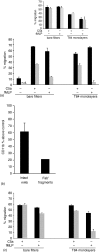
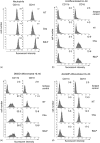
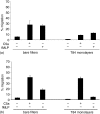
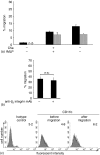
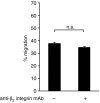
Similar articles
-
Neutrophil transepithelial migration in response to the chemoattractant fMLP but not C5a is phospholipase D-dependent and related to the use of CD11b/CD18.J Leukoc Biol. 2007 Dec;82(6):1575-84. doi: 10.1189/jlb.0806528. Epub 2007 Aug 27. J Leukoc Biol. 2007. PMID: 17724165
-
Neutrophils migrate across intestinal epithelium using beta2 integrin (CD11b/CD18)-independent mechanisms.Clin Exp Immunol. 2004 May;136(2):262-8. doi: 10.1111/j.1365-2249.2004.02429.x. Clin Exp Immunol. 2004. PMID: 15086389 Free PMC article.
-
The cell surface glycoprotein Mac-1 (CD11b/CD18) mediates neutrophil adhesion and modulates degranulation independently of its quantitative cell surface expression.J Immunol. 1989 May 15;142(10):3537-45. J Immunol. 1989. PMID: 2565926
-
Molecular events in neutrophil transepithelial migration.Bioessays. 1997 Oct;19(10):865-73. doi: 10.1002/bies.950191006. Bioessays. 1997. PMID: 9363680 Review.
-
Neutrophils and neutrophil-endothelial cell adhesion in adult respiratory distress syndrome.New Horiz. 1993 Nov;1(4):631-7. New Horiz. 1993. PMID: 7916259 Review.
Cited by
-
CD11c regulates neutrophil maturation.Blood Adv. 2023 Apr 11;7(7):1312-1325. doi: 10.1182/bloodadvances.2022007719. Blood Adv. 2023. PMID: 36306384 Free PMC article.
-
Super-Low Dose Lipopolysaccharide Dysregulates Neutrophil Migratory Decision-Making.Front Immunol. 2019 Mar 12;10:359. doi: 10.3389/fimmu.2019.00359. eCollection 2019. Front Immunol. 2019. PMID: 30915068 Free PMC article.
-
Chemotaxis and swarming in differentiated HL-60 neutrophil-like cells.Sci Rep. 2021 Jan 12;11(1):778. doi: 10.1038/s41598-020-78854-6. Sci Rep. 2021. PMID: 33436661 Free PMC article.
-
pH-Dependent migratory behaviors of neutrophil-like cells in a microfluidic device with controllability of dissolved gas concentrations.Sci Rep. 2024 Nov 20;14(1):28730. doi: 10.1038/s41598-024-79625-3. Sci Rep. 2024. PMID: 39567568 Free PMC article.
-
A chemokine receptor CXCR2 macromolecular complex regulates neutrophil functions in inflammatory diseases.J Biol Chem. 2012 Feb 17;287(8):5744-55. doi: 10.1074/jbc.M111.315762. Epub 2011 Dec 27. J Biol Chem. 2012. PMID: 22203670 Free PMC article.
References
-
- Huber D, Balda MS, Matter K. Transepithelial migration of neutrophils. Invasion Metastasis. 1999;18:70–80. - PubMed
-
- Parkos CA. Molecular events in neutrophil transepithelial migration. Bioessays. 1997;19:865–73. - PubMed
-
- Sugi K, Saitoh O, Hirata I, Katsu K. Fecal lactoferrin as a marker for disease activity in inflammatory bowel disease: comparison with other neutrophil-derived proteins. Am J Gastroenterol. 1996;91:927–34. - PubMed
-
- McAlindon ME, Gray T, Galvin A, Sewell HF, Podolsky DK, Mahida YR. Differential lamina propria cell migration via basement membrane pores of inflammatory bowel disease mucosa. Gastroenterology. 1998;115:841–8. - PubMed
Publication types
MeSH terms
Substances
LinkOut - more resources
Full Text Sources
Research Materials

